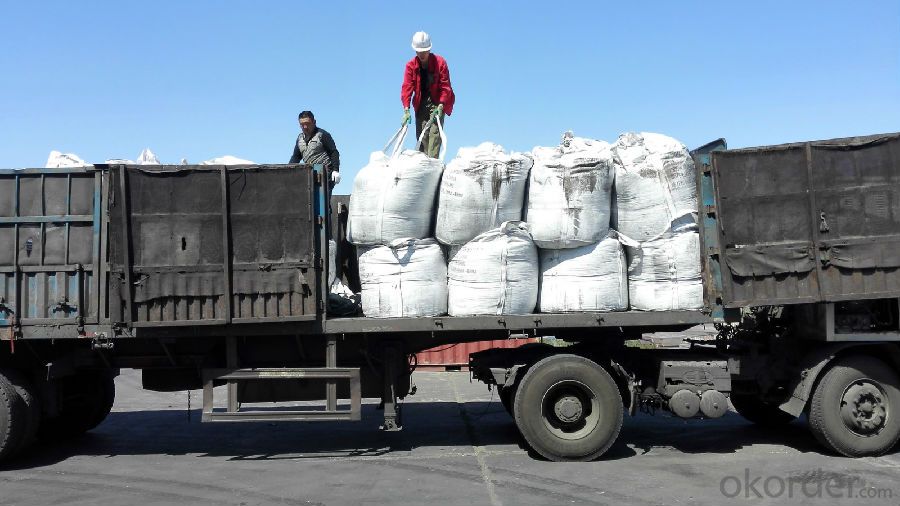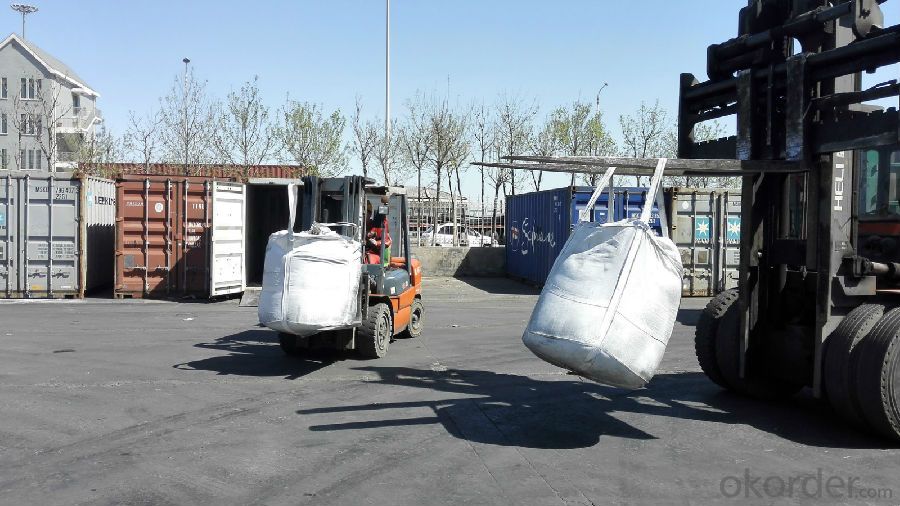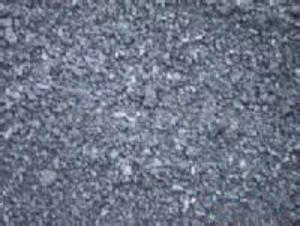FC 90% GCA made in China for steelmaking
- Loading Port:
- Tianjin
- Payment Terms:
- TT OR LC
- Min Order Qty:
- 21.2
- Supply Capability:
- 1012 m.t./month
OKorder Service Pledge
OKorder Financial Service
You Might Also Like
Introduction:
Calcined anthracite can be called carbon additive, carbon raiser, recarburizer, injection coke, charging coke, gas calcined anthracite.It is playing more and more important role in the industry
Best quality Anthracite as raw materials through high temperature calcined at over 2000℃ by the DC electric calciner with results in eliminating the moisture and volatile matter from Anthracite efficiently, improving the density and the electric conductivity and strengthening the mechanical strength and anti-oxidation. It has good characteristics with low ash, low resistivity, low sulphur, high carbon and high density. It is the best material for high quality carbon products. It is used as carbon additive in steel industry or fuel.
Features:
G-High Calcined Anthracite is produced when Anthracite is calcined under the temperature of 1240°C in vertical shaft furnaces. G-High Calcined Anthracite is mainly used in electric steel ovens, water filtering, rust removal in shipbuilding and production of carbon material. We are serving the clients from the world
Specifications:
F.C.% | 95MIN | 94MIN | 93MIN | 92MIN | 90MIN | 85MIN | 84MIN |
ASH % | 4MAX | 5MAX | 6 MAX | 6.5MAX | 8.5MAX | 12MAX | 13MAX |
V.M.% | 1 MAX | 1MAX | 1.0MAX | 1.5MAX | 1.5MAX | 3 MAX | 3 MAX |
SULFUR % | 0.3MAX | 0.3MAX | 0.3MAX | 0.35MAX | 0.35MAX | 0.5MAX | 0.5MAX |
MOISTURE % | 0.5MAX | 0.5MAX | 0.5MAX | 0.5MAX | 0.5MAX | 1MAX | 1MAX |
Pictures




FAQ:
Packing:
(1). Waterproof jumbo bags: 800kgs~1100kgs/ bag according to different grain sizes;
(2). Waterproof PP woven bags / Paper bags: 5kg / 7.5kg / 12.5kg / 20kg / 25kg / 30kg / 50kg small bags;
(3). Small bags into jumbo bags: waterproof PP woven bags / paper bags in 800kg ~1100kg jumbo bags.
Payment terms
20% down payment and 80% against copy of B/L.
Workable LC at sight,
- Q:What is carbon nanophotonics?
- Carbon nanophotonics is a field of study that focuses on the manipulation and control of light using carbon-based materials at the nanoscale level. It involves the development and exploration of carbon-based nanomaterials, such as carbon nanotubes and graphene, to design and fabricate devices that can interact with light in unique and advantageous ways for various applications in photonics and optoelectronics.
- Q:What are the industrial uses of diamonds?
- Diamonds have various industrial uses due to their exceptional hardness and thermal conductivity. They are commonly used as abrasives in cutting, grinding, and polishing tools for materials like glass, ceramics, and metals. Additionally, diamonds are utilized in the production of high-quality drill bits for drilling wells and mining operations. Their thermal conductivity makes them valuable in heat sink applications, such as in the manufacturing of computer chips and laser technology. Diamonds are also employed in the production of specialized lenses and windows for high-pressure research and industrial lasers.
- Q:Is carbon a conductor?
- Carbon is an element, not an organization, and when the carbon atoms are arranged in different spatial forms, the physical and chemical properties of the substances formed are different. When the formation of lamellar material carbon atom with six ring as a unit, the material is a conductor, which is familiar to us when graphite, carbon atoms to form a tetrahedral structure, which is macroscopically when diamond is an insulator. There are many forms of carbon elements, which are not listed in one by one
- Q:What is carbon nanocomposite coating?
- Carbon nanocomposite coatings, composed of carbon nanotubes or other carbon-based nanoparticles dispersed within a matrix material like polymer or metal, serve as a protective coating for diverse surfaces. The primary goal of these coatings is to enhance the mechanical, thermal, and electrical properties of the material being coated. By incorporating carbon nanoparticles, the coating gains strength, hardness, and wear resistance, resulting in increased durability. Furthermore, it exhibits exceptional resistance to corrosion, making it suitable for use in severe environments. A key advantage of carbon nanocomposite coatings lies in their ability to offer multifunctional properties. For instance, they can be engineered to possess high electrical conductivity, making them ideal for electronics and electrochemical devices. Additionally, they can exhibit high thermal conductivity, making them valuable for dissipating heat in electronic devices or as a thermal barrier coating. Moreover, carbon nanocomposite coatings have demonstrated promising outcomes in various sectors such as aerospace, automotive, energy, and healthcare. In aerospace, they enhance the performance and longevity of aircraft components. In the automotive industry, they provide anti-scratch and self-cleaning capabilities. In energy applications, they improve solar panel efficiency and protect oil and gas pipelines from corrosion. In healthcare, they enable drug delivery, act as antibacterial coatings, and facilitate bio-sensing applications. In summary, carbon nanocomposite coatings offer a wide array of advantages, including enhanced mechanical and electrical properties, corrosion resistance, and multifunctionality. With continuous research and development, these coatings hold immense potential for different industries, providing innovative solutions to address their unique requirements and challenges.
- Q:How does carbon impact the formation and intensity of hurricanes?
- Carbon, specifically in the form of carbon dioxide, plays a significant role in impacting the formation and intensity of hurricanes. The increase in carbon emissions due to human activities, such as burning fossil fuels, deforestation, and industrial processes, has led to a rise in atmospheric carbon dioxide levels. This, in turn, contributes to the phenomenon known as global warming. Global warming, caused by the greenhouse effect, leads to an increase in sea surface temperatures. Warmer ocean waters provide the necessary energy and moisture for hurricanes to form and intensify. As the atmosphere warms, it can hold more water vapor, which acts as fuel for hurricanes, increasing their potential for stronger and more intense storms. The warming of the atmosphere also alters the atmospheric conditions that influence hurricane formation. It changes the vertical wind shear, which is the difference in wind speed and direction at different altitudes. Low wind shear is favorable for hurricane development, as it allows the storm to organize and strengthen. However, global warming can disrupt this balance and create unfavorable wind shear patterns, inhibiting hurricane development. Furthermore, the increased carbon dioxide levels in the atmosphere contribute to ocean acidification. As carbon dioxide dissolves in seawater, it forms carbonic acid, which lowers the pH of the ocean. Acidic waters can have detrimental effects on marine life, including coral reefs, which act as natural barriers against storm surges during hurricanes. The degradation of these ecosystems weakens their ability to protect coastal communities from the destructive impacts of hurricanes. In summary, carbon emissions and the subsequent increase in carbon dioxide levels have a profound impact on the formation and intensity of hurricanes. The warming of the atmosphere and ocean, along with changes in wind shear patterns, create conditions that favor the development and intensification of hurricanes. Additionally, ocean acidification resulting from excessive carbon dioxide levels weakens natural defenses against storm surges. It is crucial to address the issue of carbon emissions and reduce our carbon footprint to mitigate the potential consequences of climate change and its impact on hurricanes.
- Q:Why can carbon fiber in addition to static electricity ah?
- Carbon fiber is a conductive substance, static electricity can not accumulate. Therefore, in the production of cloth, some of the anti - static agent, processing clothes can be anti-static. People who work at gas stations must pass on antistatic clothing so that electrical sparks from static electricity do not explode.
- Q:How does carbon affect the formation of heatwaves?
- Heatwaves are significantly influenced by carbon dioxide, a greenhouse gas. When humans release carbon dioxide into the atmosphere through activities like burning fossil fuels and deforestation, it acts like a blanket, trapping heat from the sun and preventing it from escaping into space. This is known as the greenhouse effect. As carbon dioxide levels increase, so does the Earth's temperature, resulting in more frequent and intense heatwaves. The excess heat trapped in the atmosphere creates a feedback loop, making the problem even worse. Heatwaves occur when high-pressure systems stagnate over an area for an extended period, causing temperatures to rise well above average. Carbon not only affects the intensity but also the duration of heatwaves. The enhanced greenhouse effect prolongs the duration of heatwaves, making them more perilous and destructive. Prolonged exposure to extreme heat can have severe consequences for human health, including heat-related illnesses, increased mortality rates, and reduced productivity. Furthermore, carbon emissions contribute to climate change, which alters weather patterns and leads to more extreme events like heatwaves. Climate models predict that unless carbon emissions are significantly reduced, heatwaves will become more frequent, longer-lasting, and more intense in the future. Addressing the issue of carbon emissions is essential in mitigating the impacts of heatwaves. Transitioning to cleaner and renewable energy sources, implementing energy efficiency measures, and promoting reforestation efforts are some of the steps that can be taken to reduce carbon dioxide levels. By doing so, we can mitigate the formation of heatwaves and safeguard both human health and the environment.
- Q:What are the impacts of carbon emissions on the stability of mangroves?
- Mangroves, crucial coastal ecosystems, are negatively affected by carbon emissions, which have detrimental effects on their stability. The increased levels of carbon dioxide (CO2) in the atmosphere contribute to global warming, resulting in rising sea levels and more frequent and intense storms. These changes directly impact mangroves in several ways. Firstly, global warming causes rising sea levels, leading to more frequent inundation of mangroves. As the sea level rises, saltwater intrusion occurs more often, disrupting the delicate balance of saltwater and freshwater in mangrove ecosystems. This can displace and cause a decline in mangroves, as they struggle to adapt to the changing conditions. Secondly, the increased frequency and intensity of storms due to climate change can physically damage mangroves. Mangroves act as a natural barrier, absorbing wave energy and protecting coastlines from storm surges. However, stronger storms test the resilience of mangroves, potentially uprooting or destroying them, leaving the coastlines vulnerable to erosion and further damage. Additionally, carbon emissions are linked to ocean acidification, which occurs when excess CO2 is absorbed by the oceans. Acidic waters negatively impact the growth and development of mangroves, as they are sensitive to changes in pH levels. This can lead to reduced productivity, stunted growth, and even death of mangroves, further destabilizing these ecosystems. The stability of mangroves is crucial for both the environment and human populations. Mangroves provide essential habitats for various species, acting as a nursery for fish and supporting biodiversity. They also serve as carbon sinks, absorbing significant amounts of CO2 from the atmosphere. Furthermore, mangroves play a vital role in coastal protection, mitigating erosion, storm surges, and flooding impacts. To mitigate the effects of carbon emissions on mangrove stability, it is crucial to reduce greenhouse gas emissions and limit global warming. This can be achieved by adopting clean energy sources, implementing conservation efforts, and initiating reforestation projects. Equally important is the protection and restoration of mangrove habitats, as this helps maintain their stability and resilience to climate change impacts.
- Q:What is the carbon content of 45# steel?
- The carbon content of 45# steel is about 0.42~0.50%. 45 steel is the term "GB", also called "oil steel"". Hot spot in the market; cold rolled gauge 1.0~4.0mm.
- Q:What are the impacts of carbon emissions on the stability of savannas?
- The stability of savannas, which are delicate and diverse ecosystems, is significantly affected by carbon emissions. One of the main outcomes of carbon emissions is the increase in greenhouse gases, including carbon dioxide, in the atmosphere. This results in global warming, which directly and indirectly impacts savannas in various ways. To begin with, global warming caused by higher temperatures can disrupt the natural fire regimes in savannas. These ecosystems have adapted to periodic fires, which are essential for maintaining their structure and biodiversity. However, increased temperatures can intensify and prolong fire seasons, leading to more frequent and intense wildfires. As a result, the natural balance is disturbed, resulting in the loss of vegetation, changes in species composition, and reduced overall stability of the savanna ecosystem. Additionally, elevated levels of carbon dioxide can affect the physiology and growth of plants. While some studies suggest that increased carbon dioxide concentrations may enhance plant productivity in savannas, it is important to consider other factors such as nutrient and water availability. If these factors do not keep up with the increased carbon dioxide levels, the positive effects on plant growth may be limited, resulting in imbalances within the ecosystem. Moreover, carbon emissions contribute to climate change, which alters rainfall patterns and distribution. Savannas rely on a delicate balance between wet and dry seasons, and changes in precipitation patterns can disrupt this balance. This affects the availability of water for plants and animals, leading to shifts in species distribution, reduced habitat suitability, and increased competition for limited resources. All these factors further destabilize the savanna ecosystem. Lastly, carbon emissions also contribute to ocean acidification, which affects marine ecosystems. Coral reefs, which are connected to savannas through coastal regions, provide crucial habitat and protection for many marine species. Acidic waters can harm coral reefs, leading to their decline and subsequent loss of biodiversity in savanna ecosystems. In conclusion, the stability of savannas is significantly impacted by carbon emissions. Global warming, changes in fire regimes, altered precipitation patterns, and ocean acidification all affect the delicate balance and biodiversity of these ecosystems. Addressing carbon emissions and mitigating their effects is crucial for ensuring the long-term stability and conservation of savannas and the services they provide.
1. Manufacturer Overview |
|
|---|---|
| Location | |
| Year Established | |
| Annual Output Value | |
| Main Markets | |
| Company Certifications | |
2. Manufacturer Certificates |
|
|---|---|
| a) Certification Name | |
| Range | |
| Reference | |
| Validity Period | |
3. Manufacturer Capability |
|
|---|---|
| a)Trade Capacity | |
| Nearest Port | |
| Export Percentage | |
| No.of Employees in Trade Department | |
| Language Spoken: | |
| b)Factory Information | |
| Factory Size: | |
| No. of Production Lines | |
| Contract Manufacturing | |
| Product Price Range | |
Send your message to us
FC 90% GCA made in China for steelmaking
- Loading Port:
- Tianjin
- Payment Terms:
- TT OR LC
- Min Order Qty:
- 21.2
- Supply Capability:
- 1012 m.t./month
OKorder Service Pledge
OKorder Financial Service
Similar products
New products
Hot products





























